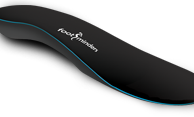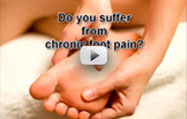Frequently Asked Questions about Footminders orthotics
Q. What are Footminders orthotics made of? Are they hard or soft?
Footminders’ orthotic technology enables our products to be firm enough to provide needed arch support, but pliable enough to provide cushioning, and to mold to your feet after a few days of wear, providing maximum walking comfort. They are made of a medium-density material called E.V.A. The major advantage of E.V.A. is that it is supportive and ‘giving’ at the same time. As you apply weight to the foot there is a certain amount of ‘give’ in Footminders orthotics, providing shock absorption to the feet, ankles, knees, hips and back. This makes the device much more comfortable and more natural compared to hard custom-made podiatrist orthotics.
Q. How can I tell which of your orthotic models is right for me?
All of orthotics are designed for problems caused by over-pronation, such as Plantar Fasciitis, heel pain, arch pain, Achilles tendonitis and others. Which model you choose depends on the type of shoe that you intend to wear them with:
- Comfort for for lace-up shoes, athletic footwear, work boots and hiking boots.
- Casual for men’s & women’s low-heeled slip-on shoes, including moccasins
- Catwalk for ladies’ fashion footwear with medium to high heel such as pumps,
sandals and boots
Q. How long will my Footminders orthotics last?
As a general rule, Footminders products will need to be replaced every 12-18 months to remain 100% effective. How often you’ll need to replace them depends on how often the orthotics are worn, and your level of activity. For example, someone who uses Footminders at work, wearing the orthotics 8 hours per day and doing a lot of walking and standing should replace them at least every 12 months. The same can be said for athletes who run long distances daily using our products.
Q. Is the price listed for a single Footminders orthotic insole, or a pair ?
All of our orthotic insole products are sold exclusively in pairs, the main reason being the answer to the question below.
Q. Only one of my feet hurts. Do I need to wear the Footminders orthotics in BOTH shoes?
Most people experience pain in only their left or right foot (or heel or knee), not in both. However, you will still need to wear the orthotics in BOTH shoes, because wearing the orthotic in only one shoe will raise one side slightly and may put your body out of balance, causing your hips to be out of aligment. So please always wear the orthotic insoles in BOTH shoes.
Q. How long will it take to get used to my new orthotics?
Because of the ‘foot-friendly’ materials used in Footminders and its anatomic shape (following the foot’s natural curves) it only takes a few days to get used to the orthotics. Most of our customers will find them comfortable immediately after inserting in them their shoes. Some people, however, need a some to get used to them, and for the Footminders orthotics to mold to you feet. If the orthotic feels strange or uncomfortable at first, we recommend you wear them only for one hour per day, and increase the wearing time by an extra half to one hour every day, until they feel completely comfortable.
Q. Will Footminders orthotics fit in all my shoes?
Yes, Footminders orthotics fit in most types of shoes. They come in different models to suit different types of footwear:
- The Casual model is designed to fit in almost every type of dress shoe, brogue, boat shoe – i.e. all low or flat-heeled footwear as long as the shoe is not too narrow.
- The Comfort model is a full-length orthotic more suited to deep, roomy lace-up shoes and boots, including all athletic footwear and also golfing shoes. Please note that the Comfort can be trimmed with scissors to fit the shoe, should they be too long.
- Footminders Catwalk is designed to fit ladies’ narrow-fitting footwear, court shoes and also medium to high heeled sandals and boots.
Q. What is the difference between Footminders orthotics and regular insoles/footbeds?
There’s a big difference between regular insoles/footbeds and orthotics! Regular footbeds are mainly designed to provide a cushioning effect and shock absorption. They may feel comfortable at first, however they do not address any biomechanical problems i.e. they do not correct overpronation. Orthotics are a functional device, designed to correct and optimize our foot function. Some footbeds also feature an arch support, but often the support is too weak to have any effect or benefit, especially if the footbeds are made of very soft materials.
How do orthotics exactly work? First of all, orthotics do a lot more than supporting the arches. Orthotics re-align the feet and ankles and restore ‘faulty’ foot function. In addition, orthotics provide an even weight distribution, taking pressure off sore spots (e.g. the heels, the ball of the foot, and corns in between toes and bunions). They also provide some degree of shock absorption, but this is not their main purpose. The main purpose of an orthotic insole is to improve foot function and in many cases this will reduce foot pain and prevent future problems and injury.
Q. Can I put Footminders insoles in the washing machine or dryer?
No, please don’t! The easiest way to clean Footminders orthotics is to simply wipe them with a warm soapy cloth. Please, do not soak them or put them in a dryer.
Q. How do I know Footminders orthotics will work for me?
Footminders orthotics have helped many thousands of people in the U.S., Europe, and Australia for the past decade. Although we cannot judge your individual situation and specific complaint, we are quite certain that our product will be of assistance by reducing or eliminating pronation-related symptoms. Foot orthotics have been used for over 40 years now, by many thousands of medical practitioners, and are still used today. The simple reason: they work!
Don’t take our word for it. We invite you to try Footminders orthotics for 30 days. If you find they have not lived up to our promise, you simply return them to us for a full money refund. No questions asked. Find out more regarding our 30 day-Money-Back Guarantee.
Q. What is the difference between Footminders and custom-made podiatrist orthotics?
Custom-made orthotics are only available from a podiatrist, in general are very rigid, and in most cases can cost several hundred dollars. Custom orthotics are for patients with serious biomechanical disorders, i.e. more serious than the common degree of excess pronation that most of us suffer from. For example, some people suffer from ‘excess supination’ – the opposite to over-pronation. Their feet roll outwards or ‘supinate’ and the arch remains high and stiff when hitting the ground (this is called a Cavus foot or High Arched foot and only affects 5% of the population). Supinators will need a custom-made orthotic that corrects this type of condition. Also, people with very large bunions, foot ulcers, foot deformities or completely flat feet will need to see a podiatrist and be fitted with a custom device. Although biomechanically correct, many patients find it very hard getting used to these custom devices, because they are very rigid and uncomfortable.
Footminders are pre-made orthotics, which are much more comfortable, not as hard as a custom-made orthotic. Footminders orthotics are not tailored to a person’s specific foot shape, however they are self-molding over time. They will gradually feel more comfortable as you use them. After approximately 4-6 weeks of wear they will entirely conform to your foot shape because of body weight and body heat. So the longer you wear them, the more comfortable they’ll feel!
Importantly for the treatment of common foot complaints (e.g. Plantar Fasciitis) podiatry research has shown that for 70-80% of people suffering from over-pronation a pre-made orthotic will provide sufficient correction and there is no real need to spend hundreds of dollars on a custom orthotic.
Q. What ailments or foot conditions can Footminders orthotics be used for?
Years of use has demonstrated that most foot complaints related to over-pronation will respond favorably to treatment with orthotics. Orthotics are found to be very effective for treating heel pain, heel spurs, plantar fasciitis, pain from bunions, callous and corns, Achilles Tendonitis, ball-of-foot Pain and Morton’s Neuroma. Our feet are the foundation of our body, and many problems in the legs, knees and back can be attributed to poor foot biomechanics. Therefore, orthotics can be very useful in the treatment of shin splints, knee pain and lower back pain. This the reason that many physiotherapists and chiropractors have started recommending the use of orthotics. Over-pronation at the feet causes the lower leg to rotate inwards and the pelvis tilt forward, in turn putting a lot of strain and stress on the legs, knees and back. Orthotics correct the problem of over-pronation and therefore greatly reduce internal leg rotation and forward pelvic tilt. A popular scientific study made in USA “identified the nature of a person’s walk as a source of chronic lower back pain”. The study further showed more than a fifty percent improvement in alleviation of back pain after wearing orthotics.



 100% Secure
100% Secure






